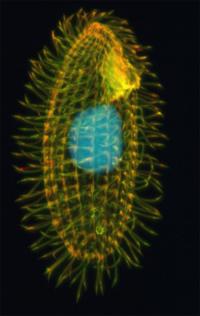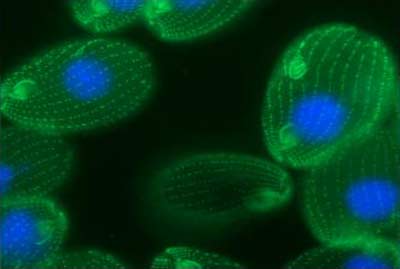A cell Tetrahymena thermophila has 25,000 genes
 Tetrahymena thermophila is a single-celled microorganism with two nuclei (Photo: biologynews.net) When in a natural environment like muddy water, this microorganism uses cilia to find ways to snatch all things through it. If no object is touched, it will act as another sensory system. Thanks to this adaptive ability, the single-celled species Tetrahymena thermophila is of particular interest to researchers.
Tetrahymena thermophila is a single-celled microorganism with two nuclei (Photo: biologynews.net) When in a natural environment like muddy water, this microorganism uses cilia to find ways to snatch all things through it. If no object is touched, it will act as another sensory system. Thanks to this adaptive ability, the single-celled species Tetrahymena thermophila is of particular interest to researchers.
Tetrahymena thermophila has a special cell with two nuclei: a small nucleus containing the necessary material for reproduction, while a large chamber of a machine creates flexibility for this organism. The group of researchers, led by Dr. Jonathan Eisen of the University of California (USA), decoded 95% of the gene.
The multiplication of Tetrahymena thermophila contains at least 25,000 genes, nearly equal to the human genome and is divided into about 200 chromosomes.
Rarely does a single-celled organism contain so many genes. This abundance has caused Tetrahymena thermophila to become an ideal experiment for geneticists. They can remove a gene and study easily what happens in the cell.
The genetic publication of this microorganism in the PloS Biology magazine will facilitate research. Its small kernel is currently being decrypted.

(Photo: utmem.edu)
WITH
- Strange creatures have 7 genders
- 'Gene therapy' Near or far?
- Human genome mystery
- The leading magazine published by Vietnamese people
- The new compound takes DNA into the damaged cell nucleus
- Find the anti-aging gene
- LEARN ABOUT ORIGINAL CELL (Part 3)
- Discover new types of cell division
- Detecting cancer in primitive animals
- Increase the efficiency of solar cells with ... sound
- Discover the path directly from outside the cell to the cell nucleus
- Identifying human genes that respond to cosmetics
 Why do potatoes have eyes?
Why do potatoes have eyes? 'Tragedy' the world's largest carnivorous life: Death becomes ... public toilet
'Tragedy' the world's largest carnivorous life: Death becomes ... public toilet Tomatoes were once considered 'poisonous' for 200 years
Tomatoes were once considered 'poisonous' for 200 years Detecting microscopic parasites on human face
Detecting microscopic parasites on human face